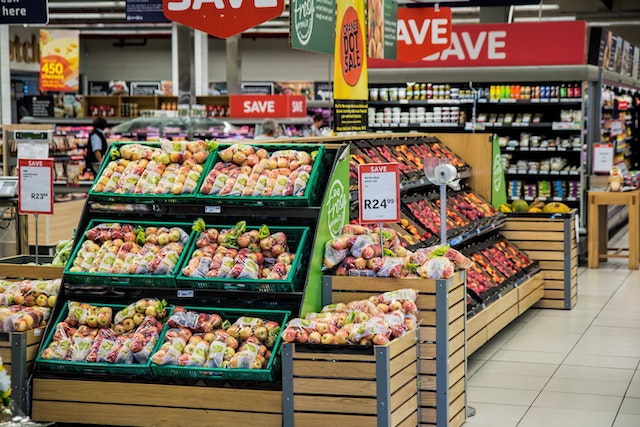
When did supermarkets start? The first supermarket was opened in 1916.
Most of us don’t think twice about pushing a cart around a supermarket and then heading to the cash register to pay. However, that is a concept that is only slightly over 100 years old. A few changes in society had to happen before the supermarket could be invented.
Ever since humans discovered agriculture and settled down in communities, people have needed to buy things they don’t have. One advantage of an agricultural society is that people can share the labor. Some people can grow crops, some people raise animals, some people make baskets, and so on. In this way, the whole community can be better off. To facilitate this arrangement, there needs to be a barter system. The person making baskets will only give up a basket if they can get some vegetables in return, and vice versa. This type of trade doesn’t require shops. The trades can be done in person. As the community grows, it gets harder and harder to visit each person producing the item that you need, and farmer’s markets appeared. In 3000 BC, in Egypt, farmers and craftsmen met in open spaces to sell their goods. It made it easier for them to sell and it made it easier for people to buy. A short while after that, money was invented and the barter system became a money-based economy.
The market system carried on uninterrupted for thousands of years. Regular people would go to the market to buy, and the stall holders would take their wares to the rich people’s estates. It wasn’t until the 13th century in Chester, England that a covered market appeared and the idea of indoor shopping took off. It was only possible to buy local food and fish, vegetables, and meat had to be bought and consumed as soon as possible. Wealthy people might have had an ice room, but poor people most likely would not. Shops didn’t have windows, counters, or display cabinets, and there was no way to test the produce before purchase.
Shops slowly evolved over the next few hundred years. By the 18th century, shops started to sell a variety of products and their interiors became closer to what we know today. International trade meant that people could buy things from all over the world, if they could afford it.
The invention of canning in 1809 increased the number of things that could be sold in a shop. Coupled with this, the rapidly expanding railways increased the number of items that could be brought in from other areas. General stores slowly started to replace specialist stores. However, the process of shopping hadn’t changed. As with a market, the customer would enter a store, hand over their shopping list, and the clerk behind the counter would fill the list and pack the groceries. This meant that the number of clerks limited the number of customers that could be served at once.
In 1916, the first supermarket was opened by Clarence Saunders in Memphis. It was called Piggly Wiggly. It differed from the regular general stores in two ways: It had fewer clerks, and it allowed the customers to gather their own purchases. This was unheard of at the time and it took some getting used to. General stores couldn’t serve many customers at once and required many clerks, which cost a lot of money. This expense was passed on to the customers in the prices. The Piggly Wiggly had customers gather their own items, which brought costs down and meant they could sell things far more cheaply than the general stores. People generally like cheap things and the store grew in popularity.
The Piggly Wiggly store model was very successful. Customers loved the freedom of being able to choose what they wanted to buy. The first shop had 605 items over four aisles, and each item was individually priced. The Piggly Wiggly Corporation patented their idea and sold franchises. This new style of shopping wrought changes in the items that the shops sold. Before, labels and packaging were very simple. They merely had the company name and the product name. Now that shoppers were choosing their own items, the packaging had to be eye catching, and branding was born.
The idea of the supermarket took another leap in 1930 when Michael J. Cullen opened a store called King Kullen. His store brought two things to the world of supermarkets and is often called the “first supermarket”. He built his store slightly outside of town and built a parking lot. The idea that people had to drive to a supermarket was new, but the number of cars in America was growing, so it worked. Also, people in cars could buy more than people on foot. The second thing was buying in bulk in order to sell at low prices. Private general stores couldn’t do this, but Cullen could use his purchasing power to get lower prices that he could pass on to his customers.
Still, again, supermarkets wouldn’t have been successful without other technological advances that happened at the same time. Cars gradually became cheaper, allowing people to travel further. Land outside of the city is cheaper and supermarkets could be bigger. But, it was the invention of the refrigerator and freezer, and their increasing popularity during the 1930s and 40s that really helped. If people could keep their produce fresh for longer, they didn’t have to shop as often, and were more likely to go to a supermarket where they could shop in bulk.
So, when did supermarkets start? In 1916, but it was the continuation of changes in society that started a century earlier. The evolution of the supermarket mirrors the changes in society through the 19th and 20th centuries. And this is what I learned today.
https://en.wikipedia.org/wiki/History_of_retail
https://time.com/4480303/supermarkets-history/
https://stacker.com/stories/3984/history-supermarket-industry-america
https://en.wikipedia.org/wiki/Piggly_Wiggly
https://en.wikipedia.org/wiki/Supermarket
